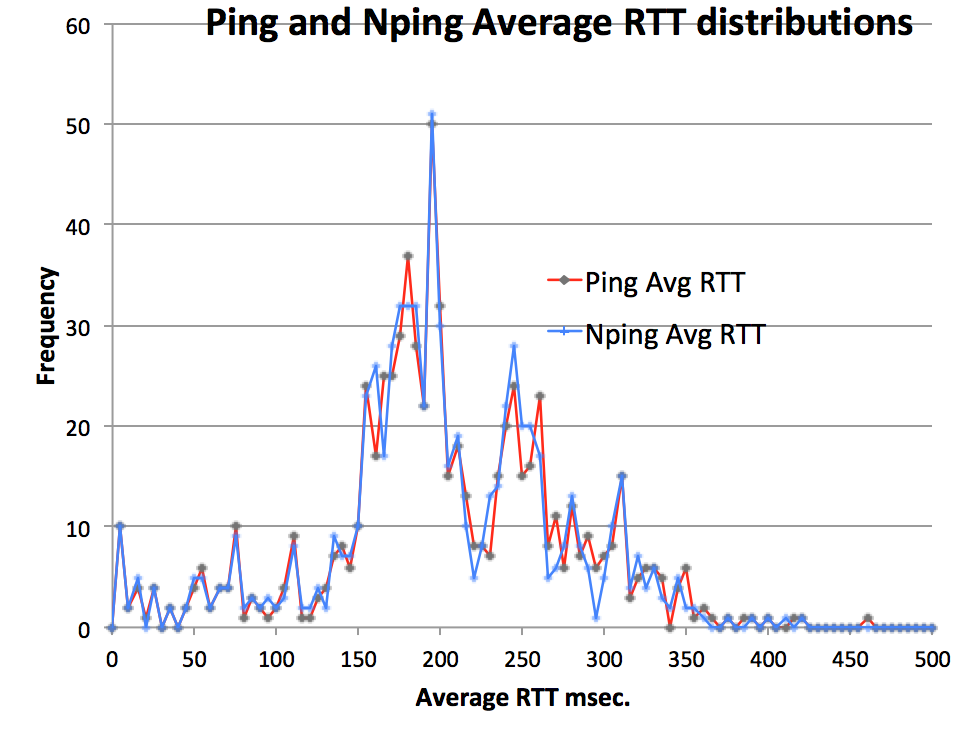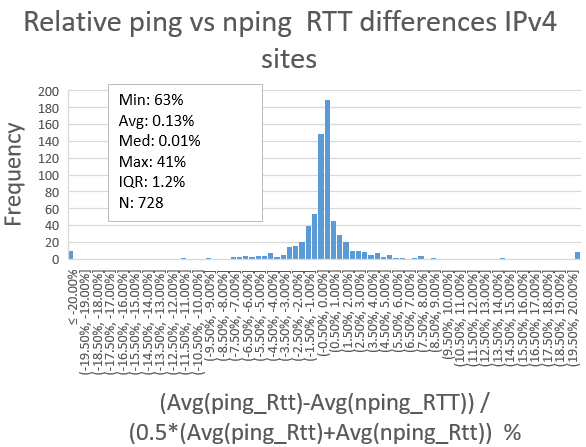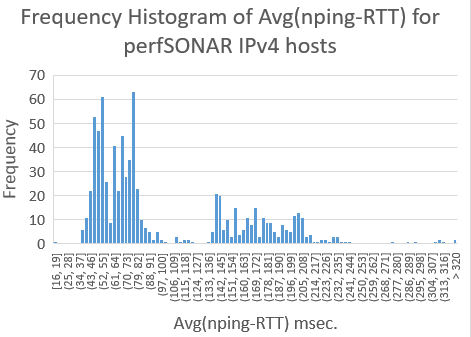...
- https://isc.sans.edu/forums/diary/Ping+is+Bad+Sometimes/11335/
- http://www.tomshardware.com/answers/id-3023937/icmp-latency-tcp-latency.html
- https://networkengineering.stackexchange.com/questions/35376/how-to-find-out-tcp-udp-latency-of-your-network
The concerns are that ICMP/ping RTT measurements are not representative of TCP RTTs since both the ISPs and the end-node sites de-priortitize ICMP compared to TCP and UDP based applications.
...
| Code Block |
|---|
486cottrell@pinger:~$sudo nping -p 80 -c 2 -6 --tcp-connect 2001:da8:270:2018:f816:3eff:fef3:bd3 Starting Nping 0.5.51 ( http://nmap.org/nping ) at 2018-01-13 15:21 PST SENT (0.0021s) Starting TCP Handshake > 2001:da8:270:2018:f816:3eff:fef3:bd3:80 RECV (0.1679s) Handshake with 2001:da8:270:2018:f816:3eff:fef3:bd3:80 completed SENT (1.0041s) Starting TCP Handshake > 2001:da8:270:2018:f816:3eff:fef3:bd3:80 RECV (1.1692s) Handshake with 2001:da8:270:2018:f816:3eff:fef3:bd3:80 completed Max rtt: 165.789ms | Min rtt: 165.073ms | Avg rtt: 165.431ms TCP connection attempts: 2 | Successful connections: 2 | Failed: 0 (0.00%) Tx time: 1.00329s | Tx bytes/s: 159.48 | Tx pkts/s: 1.99 Rx time: 1.16836s | Rx bytes/s: 68.47 | Rx pkts/s: 1.71 Nping done: 1 IP address pinged in 1.17 seconds |
Together with this we , we could use the list of PingER perfSONAR hosts that respond to pings. Note that sometimes pings are blocked to a host but TCP port 80 packets work, e.g. adl-a-ext1.aarnet.net.au (202.158.195.68).
Project
We wrote a script ping-vs-tcp.pl* for analyzing the PingER nodes, and another ping-vs-tcp-ps.pl . for analyzing perfSONAR nodes. For more information see here.
| Code Block |
|---|
Usage: ping-vs-tcp.pl [opts] Opts: -v-help print this USAGE information --Ddebug debug_level (default=0) --pprot protocol (6 or '') (default '') -a-port application port (default = 80) --ccount count of pings or npings to be sent (default = 10) Function: Ping the host provided in %NODE_DETAILS (the PingER database of hosts) For each host it gets the IP address either from NODE_DETAILS (IPv4) or using the dig command (IPv6). It then Pings and npings the host and gathers the min, average, maximum RTTs and losses and reports them to STDOUT., together with a time stamp and host information such as name, IP address, countrycontry, region etc. Externals: Requires nping (requires root/sudo privs), dig Input: It gets information on the PingER hosts from %NODE_DETAILS using: wget to get the required file from http://www-iepm.slac.stanford.edu/pinger/pingerworld/slaconly-nodes.cf. The required file is saved in in /tmp with a unique name /tmp/nodes-34589020.cf (where the number is based on the process number). Examples: ping-vs-tcp.pl ping-vs-tcp.pl -p-prot 6 -a-port 22 -c-count 10 | tee pg-v4-nd.txt ping-vs-tcp.pl -v --help Hint: To turn the output into a real csv file do something like: grep warning pg-v4-db.txt > pg-v4-nd.csv Version=0.4, 1/28/2018, Cottrell |
The output is in comma separated value format and is exported to Excel (one file for IPv4, one for IPv6) where it is analyzed to look at the histograms of AverageAvg(ping_-rtt) -Averageand Avg(nping_-rtt) etc. The script was run from a host (pinger.slac.stanford.edu) located st at SLAC in Northern California in the San Francisco Bay Area. It was run multiple times to ensure the behaviour behavior was not dependent on time of day or day of week etc. To ensure the selected target hosts were not unique in some respect we also obtained a list of target hosts from the perfSONAR project , and repeated the analysis for them. Finally, to ensure there was not something unique about making the measurements from SLAC, we repeated the measurements to the same sets of targets from MAs in China, Malaysia, and Thailand. For more information on the
IPv4 measurements
For the IPv4 data measurements using the list of PingER hosts, for the IPv4 hosts the script ran for about 6 hours and 45 minutes. The distribution histograms shown below show that the agreement between ping and nping average RTT is good:
PIngER targets from SLAC:
...
There are 728 PingER hosts responding to both ping and nping on port 80 (there are about 270 responding to port 22), 50% have Average(RTTs) for ping and nping within 2.15ms of one another. The hosts are in 160 different countries with China having the most hosts with 195, followed by the United States with 52, Indonesia with 37, Malaysia with 27 and Pakistan with 13. In terms of regions the top region is East Asia with 206 hosts, 101 from Africa, 63 from Europe and 58 from North America (Canada and the United States). There are 593 host that have 'www' in the name. The range of average ping RTTs is from 0.327ms to 377ms. The range of nping RTTs is from 2.3ms to 387ms.
The Frequency histograms of average ping and average nping RTTS are shown below (Excel spreadsheet is here)
It is seen that there is little difference in the two distributions. We thus compare the Cumulative Distribution Frequencies (CDF) by plotting their differences, note this is a step towards using the Kolmogorov–Smirnov (K-S) nonparametric test of the equality of continuous, one-dimensional probability distributions and yields a maximum difference (supremum) of 3.18% at 255 msec. K-S indicates that the probability of rejecting the null hypothesis (the null hypothesis says there is no relationship between the two measured phenomena) is very high.
To exemplify the differences in the RTTs measured by ping and nping we show the frequency distribution of the differences in the two Average RTTs. The histogram of the differences in the ping and nping averages RTTs is shown below.
Another way of looking at the data is to consider the relative differences, i.e. (Avg(ping_RTT)-Avg(nping_RTT)/(0.5(Avg(ping_rtt)+Avg(nping_RTT)), this gives the distribution below that shows the IQR of the averge difference is ~ 1.2%. If one looks at the hosts that have relative differences of > 22% or less than -22% (about 2% of the hosts), we find most are from China or have low RTTs (< 4 msec).
perfSONAR targets from SLAC
There are 786 perfSONAR target hosts that respond to both ping and nping IPv4 measurements. There are 317 in Canada and the US, 134 in 29 countries in Europe, 18 in E. Asia (all in Korea), 14 in Russia, 12 in Africa(Senega(2), Nigeria(1), Uganda(3), Niger(1), Ghana(4), Togo(1)) and 4 in each of S. Asia (3 in India and 1 in Pakistan) and Latin America (Brazil, Ecuador and Puerto Rica(2)). The regions for the other hosts are not identied in the perfSONAR database.
Histograms of the frequency distributions are shown below, the Excel spread sheet is here.:
IPv6 measurements
PingER hosts seen from SLAC MA
...
- PingER targets: 50% of the 36 hosts measured have average(RTTs) within 0.26ms of oneanother).
Again the relative ping vs nping differences for IPv6 is shown below and shows an IQR of the relative average difference is 0.45%:
perfSONAR targets
From the perfSONAR JSON configuration file we found 154 hosts that have IPv6 addresses (see spreadsheet). Of these (using the perl script bin/ping-vs-tcp-ps-sq.pl --conf ps-v6-sq.cf | tee ps-v6-sq.txt, it ran for about 45 minutes) we found 6 hosts that did not respond to ping6 and 50 for which we were was unable to get the information from nping. This yielded 98 IPv6 capable perfSONAR nodes that respond to ping6 and nping. Of these 53 are in N. America (Canada and the U.S.), 30 in Europe (13 in the United Kingdom), 4 in Russia, and 1 each in Africa (Uganda) and Costa Rica. The spreadsheet is here.
...
The MA was at a CERNET host in Beijing. The spreadsheet of the results is here.
- Histogram of difference in Avg(ping-RTT)-Avg(nping-RTT) for IPv6 measured from China
- Histogram of the relative difference between ping and nping RTTs measured from China
- Cumulative Distribution Frequency of the Avg(ping-RTT) and Avg(nping-RTT) with the differences.
The maximum(abs(Difference))=D is 0.031. We use the Kolmogorov Smirnov two sample test. for the number of observations (N), c(alpha) > D/sqrt(2N/N*N), where alpha indicates that the probability of rejecting the null hypothesis (the null hypothesis says there is no relationship between the two measured phenomena) is 85%.
Also see http://www-iepm.slac.stanford.edu/~cottrell/pinger/synack/ping-vs-synack.html and Synack and https://link.springer.com/content/pdf/10.1007%2F978-3-540-25969-5_14.pdf














